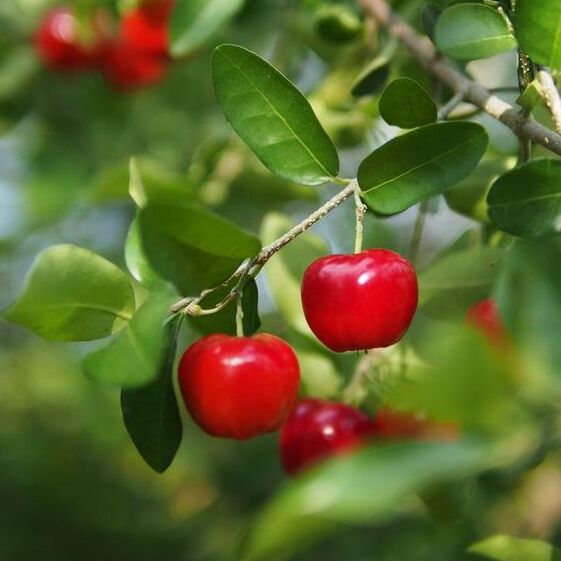Barbados Cherry plant, West India Cherry
- Rs. 349.00
-
Regular price
Rs. 660.00 -
-47%
- Will be in stock after
Vendor: Jiffy Plants
Couldn't load pickup availability
Spend Rs 1499 for free shipping
Guarantee safe checkout


Barbados Cherry plant, West India Cherry
Size: Single Plant | 2.5" Pot Included | Secure Packing
The Barbados Cherry, also known as West India Cherry or Acerola (Malpighia emarginata), is a tropical and subtropical shrub or small tree highly valued for its tart, vitamin C-rich fruits.
Here's a comprehensive guide to Barbados Cherry plant, West India Cherry's care:
1. Growing Conditions:
Sunlight: Barbados cherry thrives in full sun, requiring at least 6-8 hours of direct sunlight daily for optimal flowering and fruiting. It can tolerate partial shade, but fruit production may be reduced.
Temperature: Being a tropical plant, it loves warmth and humidity. It's best suited for USDA hardiness zones 9b-11. Mature trees can survive brief drops to around 28°F (-2°C), but seedlings are more sensitive. Protect them from frost by covering them or bringing them indoors if you live in a colder climate.
Soil: It prefers sandy to rich, well-drained soil. While it can tolerate a range of soil types, including clay-loam mixes, good drainage is crucial to prevent root rot. The ideal soil pH is between 6.5 and 8; it's more tolerant of alkaline conditions than acidic ones. Adding organic matter like compost or manure will improve soil fertility and drainage.
Wind: Due to its shallow roots, it has low tolerance to strong winds. Plant it in a location protected from harsh winds.
2. Watering:
Regular watering is essential, especially during dry spells and during flowering and fruiting. Keep the soil consistently moist but never waterlogged.
For potted plants, let the top 1-2 inches of soil dry out before watering again.
Young trees require more frequent irrigation. As the plant matures and develops deeper roots, it becomes more drought-tolerant, but still provide water during prolonged dry periods.
A soaker hose can provide slow, deep moisture.
3. Fertilization:
Established plants: Fertilize twice a year, typically in early spring before it comes out of winter dormancy, and again in late summer/mid-fall.
Young plants (first two years): Feed twice a year. After the third year, yearly fertilization might suffice, depending on growth.
Use a balanced fertilizer formulated for fruit trees, or an organic fertilizer. Avoid acidic fertilizers meant for plants like rhododendrons or citrus. Some gardeners also recommend applying compost and bone meal before springtime to encourage more fruits, and a light liquid fertilizer weekly or every 2-3 months for potted plants.
Always loosen the topsoil before applying fertilizer to help nutrient uptake, and water immediately after.
4. Pruning:
Purpose: Pruning helps maintain the plant's size and shape, improves air circulation, allows for better light penetration, and encourages new branching and fruit production.
When to prune: Prune in late winter or early spring before new growth begins, or before springtime to maintain a compact size.
Techniques:
Remove any dead, damaged, or crowded branches.
For a shrub form, trim down excess vertical growth just above a leaf or stem node to encourage side shoots.
For a tree format, keep basal sprouts in check and allow a single trunk to develop.
You can top the branches to control height, but ensure enough canopy for fruit development.
Use sterilized loppers or hand pruning shears to prevent disease.
Some sources suggest pruning aggressively (at least 12 inches off the whole plant) through winter to encourage thicker, more robust growth and prevent lanky, brittle branches.
5. Pest and Disease Control:
Barbados cherry plants are generally quite resilient.
Monitor for common pests like aphids or fruit flies.
Use organic pest control methods like neem oil, eucalyptus oil, or citrus oil sprays if necessary.
Birds and animals (like rats) can be a problem as they love the ripe fruits. You may need to net your plants to protect the harvest.
6. Harvesting:
Cherries are typically ready for harvest when they are bright red and slightly soft to the touch.
The main fruiting season is spring, but it can extend off and on all year, especially in warm climates.
Harvest fruits frequently as they ripen quickly and don't store well on the tree.
Ripe fruit is highly perishable, so use it as soon as possible or freeze it. Semi-ripe fruit can last a few days in the refrigerator.
7. Growing in Containers:
Barbados cherry trees grow very well in containers, making them suitable for patios or indoors in colder climates.
Pot size: Choose a large pot with good drainage to allow for ample root development (at least 20 inches in diameter and height).
Potting mix: Use a good quality organic potting mix that is well-draining, similar to a cactus mix. Adding mulch and compost can be beneficial.
Watering: Be careful not to overwater, as it can lead to root rot. Let the top few inches of soil dry out between waterings.
Sunlight: Place the container in a bright, sunny window (south-facing is ideal) to encourage fruit production.
Fertilizing: Potted plants generally need more consistent nutrition throughout the year. Apply organic fertilizers regularly (e.g., every 2-3 months) or a light liquid fertilizer weekly.
Repotting: When the plant outgrows its current pot, repot it with fresh potting soil and some fertilizer in the late evening, keeping it in a shady area for a few days before returning it to its sunny spot.
Winter care: If temperatures drop, bring potted plants indoors. Keeping them cooler in winter can encourage better growth and flowering in spring.
By following these care guidelines, you can enjoy a healthy and productive Barbados Cherry plant, providing you with a continuous supply of its delicious and nutritious fruits.


